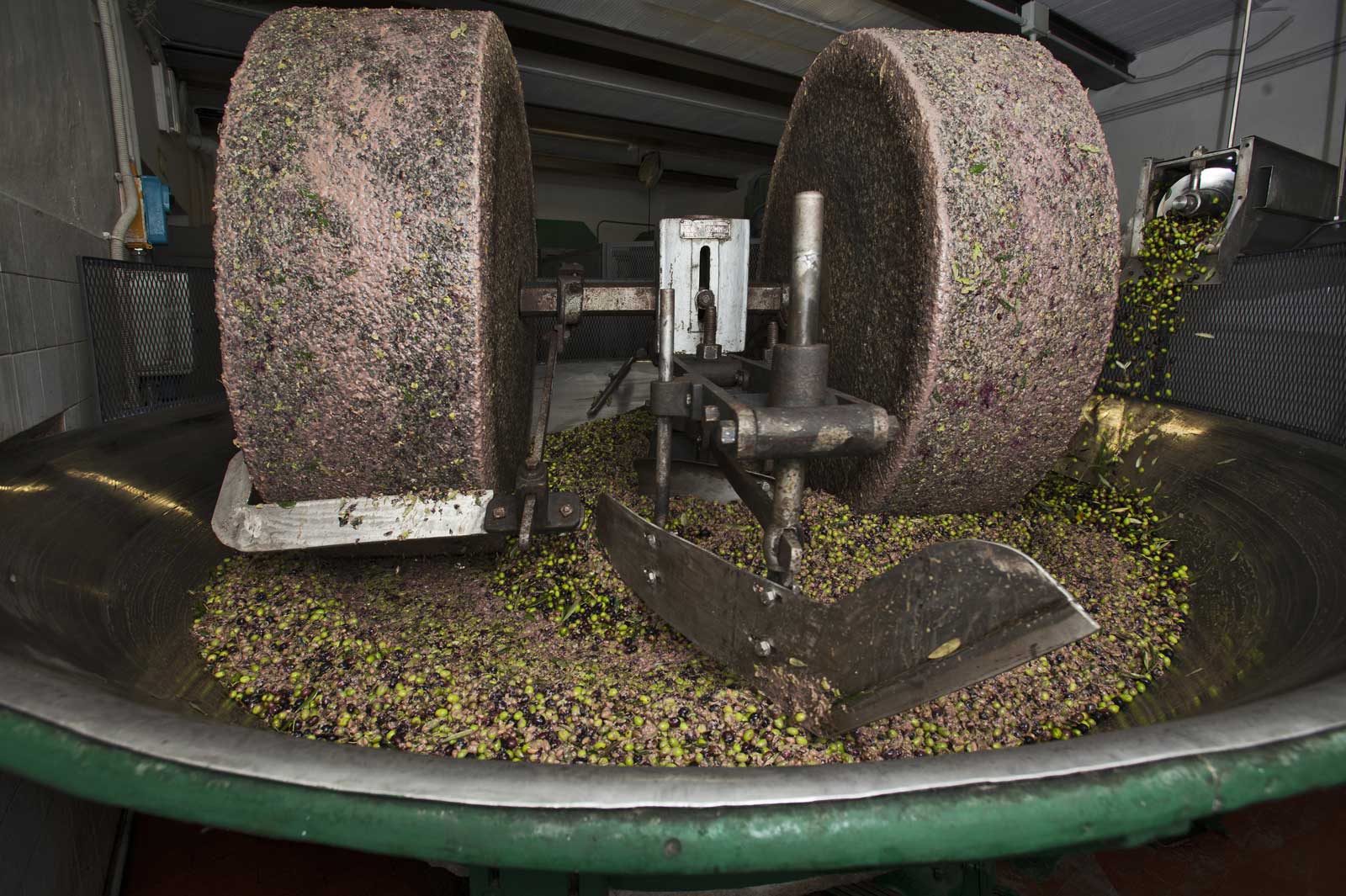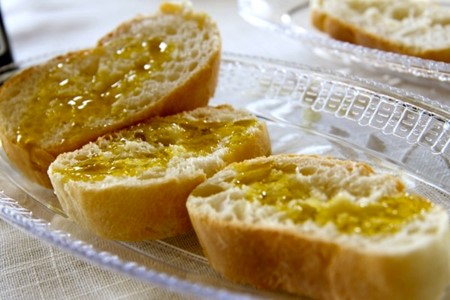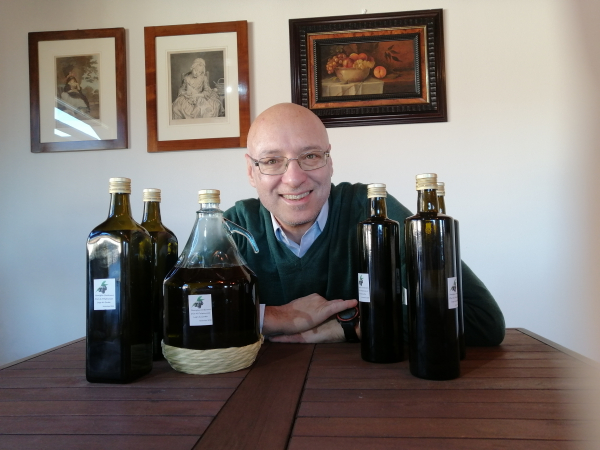At my home, olive oil is always on the table: on pasta, on salads, on meat, on fish, even raw on bread, someone even says that we drink it because we consume an exaggerated amount of it. Now, after harvesting olives at my father’s grove on Lake Garda, the time has come to get our new EVO from the oil mill.
As usual, first a little history. Legend tells that the goddess Athena and the sea god Poseidon were rivals for the domination of Attica and the city that was to take its name from Athena. And so, there was a competition with Zeus as the judge and the one who brought the most useful gift for humanity would win. Athena ordered the earth to give birth to a marvellous tree, the olive, and Zeus declared her the winner.
The origins of olive oil are lost in the night of time. The earliest evidence of the use of oil dates back to 4000 B.C., in Armenia and Palestine. The Greeks were the first to set up oil mills and elaborate on the techniques of olive oil production. They also expanded the olive cultivation throughout Southern Italy, the so-called Magna Grecia, starting from the 8th century BC. After them, the Romans extended it to all territories of the Empire, France and Spain in particular, even imposing the payment of taxes in the form of olive oil. Thus, the first classifications were born and the first figures of specialized sellers were created.
After the fall of the Roman Empire, the cultivation of the olive tree was abandoned and for centuries the olive groves survived only in a few territories. It was only after the year 1000 AD that olive groves began to expand once again, also thanks to donations of land plots by convents and monasteries. The final relaunch occurred later, when Venetian, Florentine and Genoese merchants took it to the East and Northern Europe. From that moment Italian olive oil became famous and renowned, and in 1400 Italy became the largest producer of olive oil in the world. Italian olive oil was popular throughout Europe and from 1700 some Italian regions defined their olive vocation.
In the second half of the 20th century, due to the economic boom, olive oil began to be considered a poor element and was replaced by the richest animal fats. Today olive oil has returned to its prestigious role, especially after the nutritional benefits for health have been confirmed; in fact, it is a natural defence against diseases, lowers the levels of bad cholesterol and slows down bone ageing, all thanks to polyphenols, natural antioxidant organic molecules that prevent the ageing process. Perhaps it is the high consumption of olive oil in Italy which contributes to its high average life expectation: more than 83 years (by the way, life expectation is even higher in Spain, another region where they use EVO a lot).

CHARACTERISTICS OF EXTRA VIRGIN OLIVE OIL
EVO comes only from the first mechanical squeezing of ripening olives, with a process called “cold squeezing", meaning that the temperature of the crushed olive paste during the reshuffling phase should not exceed 27°C. This process allows extracting the oil from the olives, preserving the minerals, vitamins and all substances rich in antioxidant properties for the body at best. The “cold-squeezing” technique guarantees a superior oil quality, though with a lower commercial yield for the producer.
EVO oil must have well-defined chemical characteristics. The most important concerns oleic acidity, which must be less than 0.8%. Acidity is not perceptible to taste but can be detected only with an analysis in the laboratory. In fact, the size of free fatty acids is so small that it cannot be perceived by human taste buds.
An EVO has 3 main characteristics:
a) Fruity
b) Bitter
c) Spicy
The possible value of these parameters ranges from a minimum of 1 to a maximum of 10. For example, an EVO could have the following values: fruity 8, bitter 2, spicy 1. The EVO organoleptic characteristics are quite simple since EVO is not a product obtained by fermentation: it must have a predominant aroma of green olives, cut grass, raw artichokes, and sometimes more complex aromas, from green tomatoes to almond and apple. To be classified as EVO, an olive oil must be submitted to a panel of tasters enrolled in a professional register, who determine whether the product has the requirements to be defined as "Extra Virgin"; each Italian region has its register of tasters.

IN THE KITCHEN
EVO is perhaps the condiment that makes the most difference in the preparation of a dish. If it is good, it enhances and emphasizes the qualities of the ingredients used. If it is bad, it can turn off and spoil even a well-prepared dish. For these characteristics, the Italian EVO is an excellent ingredient of the typical dishes of all Italian regions, simple but very tasty foods. It is used raw, for condiments, and for the preparation of cooked foods such as sauces, meat or fish dishes, and even desserts. It can be used for frying, as long as it never reaches a temperature exceeding the point of smoke, when it would release toxic substances.
In Italy, we use EVO almost everywhere. My favourite recipe is the simplest one, with a “garlic and tomato bruschetta”. On fresh fish, or rather, on a product with a light flavour such as fresh or freshly boiled vegetables, you should use a very delicate oil to enhance the taste of the vegetable. On a roasted Florentine, you better go with a bitter, slightly spicy oil. In any case, part of the success lies in the combination itself, but certainly the most important factor is the taste and habit of those who taste the dish.

HOW TO CHOOSE EVO
Not all EVOs are the same. The real difference lies not so much in whether it is regional, Italian, EU or extra-EU, but in the method of production. We must therefore distinguish between artisanal and industrial EVO. Cultivars mix, biodiversity, typicality, creativity, production techniques, all these combined factors lead to the diversification of aromas and flavours. Artisan oil is not a competitor with industrial EVO, it's a different, unique product. The oil comes from a wise and ancient art, the one of Maestri Oleari (Oil Masters), food craftsmen who expertly and always differently produce olive oil. Starting from the different Italian olive varieties (cultivars, remember?), they manage to transform them, with the suitable processing techniques, into a unique product, the result of their know-how. They decide which type of gramola (reshuffling) is most suitable for certain olive varieties, they select processing times and temperatures. Many variables can come into play from the moment the olive is harvested to be turned into a certain extra virgin olive oil, and its quality and taste depend on the mastery and professionalism of the Maestro Oleario.
Fortunately, thanks to quality certifications, buying a good oil is very simple. It is enough to choose EVOs with a denomination of origin, which are 100% Italian, have a defined origin and peculiar characteristics and are subject to regular organoleptic checks. Italy has 41 DOPs (Denominazione di Origine Protetta, "protected designation of origin"), a product protection mark recognized by the European Union. DOPs protect a food product whose characteristics depend on the territory in which it was produced. And be careful: not always an Italian name is synonymous with Italian oil, many companies use "Italian" names for products that contain nothing Italian, it is called "Italian Sounding": stay away from it, they are cheating you!
BUT WHAT IS THE BEST EVO IN ITALY?
In every Italian region we can find oils with a more or less intense flavour. It is not enough to know the region but it is important to know the cultivar from which the EVO is produced. There is not an EVO better than another: there is the quality of the oil. But even we Italians tend to classify the different EVOs according to their origin, as there are regions more suited to oil production. When it comes to oil, do we not all think of Puglia? There are so many varieties in this region, a symbol par excellence of olive oil differentiation across a territory. An exceptional EVO is the one from Cellina di Nardò and Ogliarola, already cultivated 6,000 years ago. Sicily is also home to some of the tastiest EVOs. Every part of the region produces oils, which are also very different from each other: for example, in the Etna area, the Etna DOP has a very intense taste. In the western part of the island, Valli Trapanesi DOP, from Nocellara del Belice and Cerasuola olives, is milder and less "volcanic". Tuscany is among the undisputed and oldest queens in the production of high-quality EVO. It is the region with the most cultivars of all, with many denominations: Chianti, Lucca, Terre di Siena PDO or simply Tuscan IGP! Finally, we should not forget Umbria in Central Italy, with its Umbria DOP. The commercial activity related to oil production dates back to the first century B.C. when Umbrian oil reached Rome. This EVO is particularly sweet, thanks to very low acidity.

AND THE WINNER IS……..MY EXTRA VIRGIN OLIVE OIL (OBVIOUSLY)
It could not be otherwise. Here it is, my Champion, I just got it from the oil mill of our Maestro Oleario, Mr Morani. My wife has created labels, and now we are going to live the most exciting moment, tasting it raw with bread.
More seriously, olive tree cultivation on the shores of Lake Garda has ancient origins and traditions. Local people have cultivated olive trees since Roman times, and already since the Middle Ages Garda oil was renowned for its high quality and high economical value. During the Renaissance, human activity defined the distinctive traits of the agricultural landscape and generally of Lake Garda. In this age, slopes started to be redesigned with elaborate arrangements, which became proper "terraced" constructions facing towards the lake, suitable for olive tree grove and even lemon cultivation. Garda oil, thanks to the favourable Mediterranean microclimate of the territory, is the EVO produced in the northernmost area in the world and, I assure you, it is as good as oil produced in Central and Southern. The mountains and the water basin, making the climate of Garda similar to that of the Mediterranean, create the ideal conditions for the olive tree to thrive. It is an oil of great value, light, rich in chlorophyll, savoury and harmonious, with an intense green-gold colour and a delicate scent of sweet almond. The low acidity and its lightness make it suitable for the most varied uses in the kitchen. I use it everywhere, on meat carpaccio or bresaola, with cheese, fish and vegetables (I eat huge quantities of vegetables every day), in soups and vegetable creams.
The time has come: hot bread and oil. Mmmmm. This year too, our land has offered us a precious gift, which will accompany us throughout 2021 and beyond. A little satisfaction in this difficult period, but for this very reason, even more important. Life goes on, after all.
Ciao da Marcello

P.S. April, May, June and September are the best months to visit Lake Garda! And in November, when we harvest our olives, the weather is still very mild! We usually take our friends to visit and make tasting in the best olive oil mills, organize dinners in the vineyards, then trekking, boat excursions, sunbathing, “aperitivo” by the lake in a relaxing atmosphere. We live in a wonderful area, and we will be happy to host you here!!!

